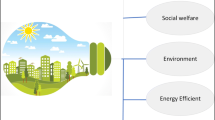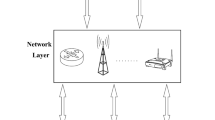Abstract
Fog computing enables cloud and edge resource integration. It provides intelligent, decentralized processing of the amount of data generated by the Internet of Things (IoT) sensors for seamless integration of physical and cyber environments. This can create many benefits for society. The IoT framework uses wireless nodes to collect data and monitor the environment. Therefore, the limited power of batteries and the network lifetime are two essential problems in an IoT-based environment. Reducing energy consumption and fast transmission of collected data for reducing the response time can be improved the performance of IoT. Sending data packets by the appropriate header nodes can reduce the communication latency to the Fog. So, in the first step of the proposed method, the header nodes are selected based on many factors including the criteria of residual energy, speed of nodes, and number of neighbors in the Fog-IoT method. In the second phase, we implement a self-adapting algorithm using a control loop to solve the service location problem in the Fog-IoT approach. By considering the feature of self-adapting computing which refers to the self-management features of the distributed computing resources, the proposed method provides an optimal and centralized framework and methodology for solving the problem of deploying the Fog service based on self-adapting computing. Therefore, the real-time application requested and tasks allocation can be dynamically accepted in the shortest possible time in the Fog and the result returns to the IoT-based wireless devices. The simulation of the proposed method under the several performance metrics including the packet delivery ratio, throughput, and network lifetime has been compared with the previous works. The results show that the proposed Fog-IoT method improves all metrics in various scenarios.






Similar content being viewed by others
Availability of data and materials
Not applicable.
References
Mekki K, Bajic E, Chaxel F, Meyer F (2019) A comparative study of LPWAN technologies for large-scale IoT deployment. ICT express 5(1):1–7
Li H, Ota K, Dong M (2018) Learning IoT in edge: Deep learning for the Internet of Things with edge computing. IEEE Network 32(1):96–101
Mahmud R, Kotagiri R, Buyya R (2018) Fog computing: A taxonomy, survey and future directions. In Internet of everything (pp. 103–130). Springer, Singapore
Brogi A, Forti S, Guerrero C, Lera I (2020) How to place your apps in the Fog: state of the art and open challenges. Softw Pract Exp 50(5):719–740
Alrawais A, Alhothaily A, Hu C, Cheng X (2017) Fog computing for the internet of things: security and privacy issues. IEEE Internet Comput 21(2):34–42
Aazam M, Zeadally S, Harras KA (2018) Offloading in Fog computing for IoT: Review, enabling technologies, and research opportunities. Futur Gener Comput Syst 87:278–289
Hu P, Dhelim S, Ning H, Qiu T (2017) Survey on Fog computing: architecture, key technologies, applications and open issues. J Netw Comput Appl 98:27–42
Arkian HR, Diyanat A, Pourkhalili A (2017) MIST: Fog-based data analytics scheme with cost-efficient resource provisioning for IoT crowdsensing applications. J Netw Comput Appl 82:152–165
Skarlat O, Nardelli M, Schulte S, Dustdar S (2017) Towards qos-aware Fog service placement. In: 2017 IEEE 1st International Conference on Fog and Edge Computing (ICFEC), pp 89–96. IEEE
Zeng D, Gu L, Guo S, Cheng Z, Yu S (2016) Joint optimization of task scheduling and image placement in Fog computing supported software-defined embedded system. IEEE Trans Comput 65(12):3702–3712
Barcelo M, Correa A, Llorca J, Tulino AM, Vicario JL, Morell A (2016) IoT-cloud service optimization in next generation smart environments. IEEE J Sel Areas Commun 34(12):4077–4090
Wen Z, Yang R, Garraghan P, Lin T, Xu J, Rovatsos M (2017) Fog orchestration for internet of things services. IEEE Internet Comput 21(2):16–24
Fan Q, Ansari, N (2017) Cost aware cloudlet placement for big data processing at the edge. In: 2017 IEEE International Conference on Communications (ICC), pp 1–6. IEEE
Ni L, Zhang J, Jiang C, Yan C, Yu K (2017) Resource allocation strategy in Fog computing based on priced timed petri nets. IEEE Internet Things J 4(5):1216–1228
Taneja M, Davy A (2017). Resource aware placement of IoT application modules in Fog-Cloud computing paradigm. In: 2017 IFIP/IEEE Symposium on Integrated Network and Service Management (IM), pp 1222–1228. IEEE
Wang S, Zafer M, Leung KK (2017) Online placement of multi-component applications in edge computing environments. IEEE Access 5:2514–2533
Sun H, Yu H, Fan G, Chen L (2020) Energy and time efficient task offloading and resource allocation on the generic IoT-Fog-cloud architecture. Peer Peer Netw Appl 13(2):548–563
Venticinque S, Amato A (2019) A methodology for deployment of IoT application in Fog. J Ambient Intell Humaniz Comput 10(5):1955–1976
Guerrero C, Lera I, Juiz C (2019) A lightweight decentralized service placement policy for performance optimization in Fog computing. J Ambient Intell Humaniz Comput 10(6):2435–2452
Mahmud R, Ramamohanarao K, Buyya R (2018) Latency-aware application module management for Fog computing environments. ACM Trans Internet Technol TOIT 19(1):1–21
Mahmud R, Srirama SN, Ramamohanarao K, Buyya R (2019) Quality of Experience (QoE)-aware placement of applications in Fog computing environments. J Parall Distribut Comput 132:190–203
Velasquez K, Abreu DP, Curado M, Monteiro E (2017) Service placement for latency reduction in the internet of things. Ann Telecommun 72(1–2):105–115
Minh QT, Nguyen DT, Van Le A, Nguyen HD, Truong A (2017). Toward service placement on Fog computing landscape. In: 2017 4th NAFOSTED Conference on Information and Computer Science. pp 291–296. IEEE
Skarlat O, Nardelli M, Schulte S, Borkowski M, Leitner P (2017) Optimized IoT service placement in the Fog. SOCA 11(4):427–443
D’Angelo M (2018) Decentralized self-adaptive computing at the edge. In: 2018 IEEE/ACM 13th international symposium on software engineering for adaptive and self-managing systems (SEAMS), pp 144–148
Skarlat O, Nardelli M, Schulte S, Dustdar S (2017) Towards Qos-aware Fog Service Placement. In: Fog and Edge Computing (ICFEC), 2017 IEEE 1st International Conference on. IEEE, pp 89–96
Funding
The authors declare that they have no known competing financial interests or personal relationships that could have appeared to influence the work reported in this paper. No funds, grants, or other supports was received.
Author information
Authors and Affiliations
Contributions
All authors have participated in (a) conception and design, or analysis and interpretation of the data; (b) drafting the article or revising it critically for important intellectual content; and (c) approval of the final version. This manuscript has not been submitted to, nor is under review at, another journal or other publishing venue. The authors have no affiliation with any organization with a direct or indirect financial interest in the subject matter discussed in the manuscript. This paper is an excerpt from a PhD dissertation.
Corresponding author
Ethics declarations
Conflict of interest
The authors declare that they have no conflict of interest.
Ethical approval
Not applicable.
Consent participate
Not applicable.
Additional information
Publisher's Note
Springer Nature remains neutral with regard to jurisdictional claims in published maps and institutional affiliations.
Rights and permissions
About this article
Cite this article
Ghaferi, E., Malekhosseini, R., Rad, F. et al. A clustering method for locating services based on fog computing for the internet of things. J Supercomput 78, 13756–13779 (2022). https://doi.org/10.1007/s11227-022-04393-8
Accepted:
Published:
Issue Date:
DOI: https://doi.org/10.1007/s11227-022-04393-8




